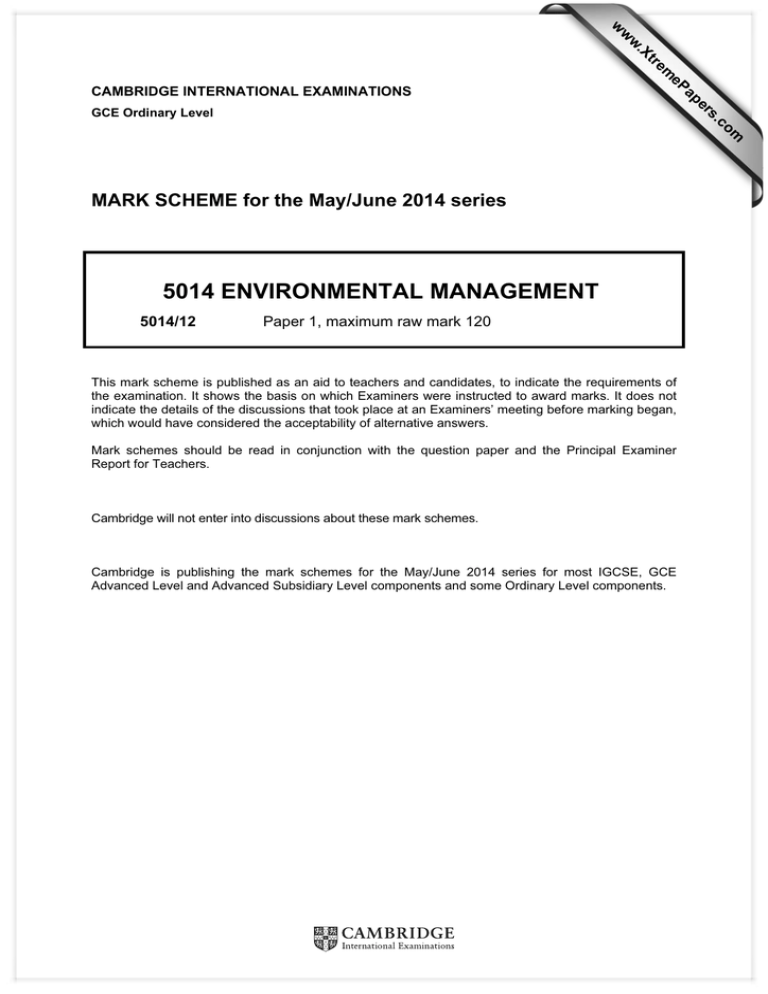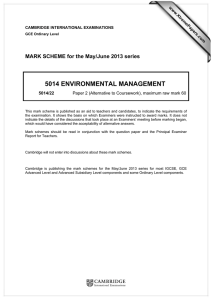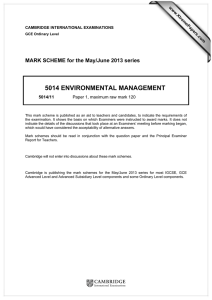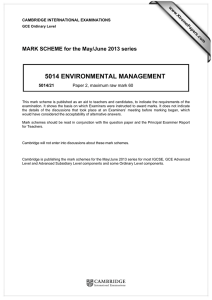5014 ENVIRONMENTAL MANAGEMENT MARK SCHEME for the May/June 2014 series
advertisement

w w ap eP m e tr .X w CAMBRIDGE INTERNATIONAL EXAMINATIONS s er om .c GCE Ordinary Level MARK SCHEME for the May/June 2014 series 5014 ENVIRONMENTAL MANAGEMENT 5014/12 Paper 1, maximum raw mark 120 This mark scheme is published as an aid to teachers and candidates, to indicate the requirements of the examination. It shows the basis on which Examiners were instructed to award marks. It does not indicate the details of the discussions that took place at an Examiners’ meeting before marking began, which would have considered the acceptability of alternative answers. Mark schemes should be read in conjunction with the question paper and the Principal Examiner Report for Teachers. Cambridge will not enter into discussions about these mark schemes. Cambridge is publishing the mark schemes for the May/June 2014 series for most IGCSE, GCE Advanced Level and Advanced Subsidiary Level components and some Ordinary Level components. Page 2 Mark Scheme GCE O LEVEL – May/June 2014 Syllabus 5014 Paper 12 Section A 1 (a) (i) oceanic plate; magma reservoir; crater; Accept labels if there is no ambiguity. One mark per correct label. [3] (ii) crust; [1] (iii) destructive / convergent/collision; [1] (iv) oceanic plate moves beneath continental plate/subduction; friction creates heat; rocks melt; [2] (b) eruptions of lava / lava flows; volcanic bombs; eruptions of hot / poisonous gases; eruptions of ash; earthquakes; mud flows / lahars landslides; pyroclastic flows / nuées ardentes; Must relate to a volcanic hazard, so not unspecified death, loss of houses, loss of farmland, etc. [3] 2 (a) (i) trade winds weaken; allows warm water / ocean current to move eastwards / into the area; prevents cold water reaching the surface; (ii) Any sensible reasons, such as: (more) rainfall / water; replenishing fresh water supplies; growth of vegetation; food for herbivores; more prey for carnivores; healthier so more survive; more reproduction; dead fish washed up as food source; © Cambridge International Examinations 2014 [3] [4] Page 3 3 Mark Scheme GCE O LEVEL – May/June 2014 Syllabus 5014 Paper 12 (b) nutrient rich cold waters do not reach the surface; warm current poor in nutrients; seaweed / algae deprived of nutrients; seaweed / algae die; lack of food for marine iguanas; weakened animals die / only the fittest survive; weakened animals more susceptible to predators; [3] (a) (i) addition of 1912 and a bar representing 40 000 for Bangladesh; [1] (ii) Credit ideas, such as: more deaths after 1950; except in India; no deaths in Myanmar before 1950; more deaths in Bangladesh China (Myanmar) pre-1950; (b) very strong winds; very heavy rainfall; storm surge / flood; [2] [2] (c) Allow any sensible factor with development, such as: the type of land and its location more deaths if: flat land; lowland; delta; at the coast; head of a bay; Allow development points, such as: so area easily flooded; so prone to storm surges / tidal waves; so nothing to break the force of the wind; so water cannot drain quickly away; etc.; Allow converse for fewer deaths but do not credit the converse ideas for both. human and economic reasons population growth over time; densely populated / large population; flimsy/poorly built buildings; poor transport for rapid evacuation; inadequate warning systems; inadequate post cyclone relief systems; inadequate numbers of cyclone shelters; poverty of developing countries; disease (e.g. cholera); famine; etc.; Max. three marks on either part. © Cambridge International Examinations 2014 [5] Page 4 4 Mark Scheme GCE O LEVEL – May/June 2014 Syllabus 5014 Paper 12 (a) (i) completion of graph line for total to 160 million hectares; [1] (ii) 45%; [1] (iii) 2001 or 2002; [1] (b) (i) increased yields / reduced consumption of crops by insects; reduced transmissions of disease to crops by insects; less need for pesticide; improves farmer’s finances; [2] (ii) improved diet / better health / growth and repair; commands higher price; [1] (iii) Allow any sensible suggestion, such as: pollen / genetic material may escape into the natural vegetation around, leading to a change in the natural vegetation; could out-compete the natural vegetation; could lead to loss of varieties; some believe it could lead to illness / health concerns; such as cancer / other relevant named illness; people may be allergic to the products; some people object on moral grounds / believe we should not interfere with nature; resistant to change / new ideas; [4] © Cambridge International Examinations 2014 Page 5 Mark Scheme GCE O LEVEL – May/June 2014 Syllabus 5014 Paper 12 Section B 5 (a) (i) around the Equator / both sides of the Equator / mainly in the tropics; names of the continents / countries; some ides of the relative size / extent within / between continents; [2] (ii) (most) in cold temperate / southern edge of polar latitudes; more detailed description in relation to latitude 60°N; some idea of the relative size / extent within / between continents; names of the continents / countries; [2] (iii) tropical compared with temperate; tropical north and south of the Equator compared with taiga northern hemisphere only; longer more continuous unbroken extent for taiga across the continents / vice-versa for tropical rainforest; tropical more spread out / dispersed; [1] (b) Forest layers – taiga Tree shape – taiga 1 or 2 one mark two of: conical shape; downward sloping branches; branches all the way up the stem; Leaf characteristics two marks – tropical rainforest one of: drip tips (pointed ends); large / broad leaves / leathery; network of veins; one mark – taiga one of: needle leaves; small / hard; waxy; dark colour; Examples of named types of trees – taiga pine, spruce, larch one mark one mark © Cambridge International Examinations 2014 [6] Page 6 Mark Scheme GCE O LEVEL – May/June 2014 Syllabus 5014 Paper 12 (c) (i) 26 °C [1] (ii) The following factors temperature – high and constant in tropical rainforest – fluctuates to very low in winter in taiga rainfall – tropical rainforest receives rain all year round / tropical rainforest has higher rainfall – taiga has long dry spells No marks for difference as question is about explaining differences in vegetation that result. Used to explain the chosen differences in biodiversity, forest layers, tree shape, leaf characteristics, etc., e.g.: conical trees to shed snow in taiga, no snow in tropical rainforest; evergreen leaves in taiga so can start photosynthesis as soon as warm enough; and not waste energy growing new leaves, whereas no ‘energy’ shortage in tropical rainforest; drip tip leaves in tropical rainforest to remove high rainfall; needle leaves in taiga to reduce water losses as so dry, etc.; [3] (iii) the high temperature and rainfall in tropical rainforest result in: more opportunities for using the deforested land; fast /all year crop growth; 2 or 3 crops per year can be grown; wide range of different crops can be grown; faster nutrient cycling; more population in tropical rainforest; timber from tropical rainforest more valuable; ORA for taiga. [3] (d) (i) rises initially; slow rise to 2001; then quicker rise; followed by fall; peaks at 2004 / 27 100 – 27 500 km2; then decreases; decrease steeper than increase; falls lower than it was in 1999; small rise again in 2008; Max. one mark for data quoted. © Cambridge International Examinations 2014 [3] Page 7 Mark Scheme GCE O LEVEL – May/June 2014 Syllabus 5014 Paper 12 (ii) Positive points: the amount deforested has declined fast; the annual clearance by 2010 is only about a quarter of what it was at the peak in 2004; by 2006 it had fallen to levels not previously seen between 1999 and 2004; Negative points: the forest clearances are still continuing; there was a slight increase from 2007 to 2008; therefore reductions in amount cleared cannot be taken for granted; 45% already cleared; Max. one mark for relevant data. (e) (i) National Parks and nature reserves; (accept NP and NR) [3] [1] (ii) legal protection to natural environments / prevent exploitation; international recognition / reputation / show importance of rainforest to people; funds for research; ecotourism is maintained / money from ecotourists; [1] (iii) buffer zone stretches the full width / across the southern edge of the reserve; to limit the amount of human activity; so that it conserves the core; separates the core from the areas outside the reserve without protection; [2] (iv) the new activities are a source of income for local people; conservation is encouraged when they can make a living by sustainably harvesting forest products; sustainable harvesting preserves biodiversity (for future use); a fair trade organisation helps them to market overseas; a fair trade organisation guarantees prices / market outlets / adds money for use in community projects; Max. two marks on either how or why. [3] (v) employ local people: as tourist guides; in maintenance and management of the parks; in tourist facilities; to make tourist souvenirs; government channelling money back into infrastructure / local facilities; Max. two marks for list. One idea explained well can get all three marks. © Cambridge International Examinations 2014 [3] Page 8 Mark Scheme GCE O LEVEL – May/June 2014 Syllabus 5014 Paper 12 (vi) distant from main cities / law enforcement authorities; large area to police; expensive to police effectively; forest difficult to travel through; people desperate for food / employment; growing population puts pressure on land; corruption; drug cartels threaten government / weak government; [2] (vii) poor chance: government not well developed; average income per head shows that Guatemala is a developing country; government have greater priorities for spending its limited economic resources; people poor so will risk illegal activity; if locals don’t cooperate; high cost of creating /enforcing; good chance; world biosphere reserves are internationally recognised and supported; easier for governments in poor countries to attract funding; and outside expertise; ecotourism can provide jobs / income; Max. three marks if only one side addressed. © Cambridge International Examinations 2014 [4] Page 9 6 Mark Scheme GCE O LEVEL – May/June 2014 Syllabus 5014 Paper 12 (a) (i) line drawn across the graph at 20; [1] (ii) 12 times circled or otherwise clearly indicated; [1] (iii) health issues leads to loss of work days; wealthy / wealth creators move away; e.g. of health issue (bronchitis / asthma / irritates eyes / skin irritation / breathing difficulties); transport issues caused by fog / smog; costs to industry of permits to pollute / cleaning effects of pollution; [3] (iv) satisfying essential domestic needs for energy; people / industries using the cheapest energy source / cost implications; people using the one most readily available to them; too engaged in survival to consider environmental effects; cannot afford alternative fuels; increasing wealth of population leads to greater fuel use (cars); (cleaner) alternative fuels not available; high density / concentrated population; [3] (b) (i) plotted accurately for the scale used Four correct for two marks, two or three correct for one mark. with axes numbered and labelled; [3] (ii) high air pressure – sinking air so that pollutants are trapped in the lower atmosphere; high pressure associated with low wind speeds / calm weather; calm conditions – increasing temperature with height stops air rising and dispersing; pollutants not dispersed by winds; steep sided hills – pollutants are trapped in the basin between steep sided mountains; less able to be dispersed by winds; [3] (iii) banning cars from city centres; according to registration numbers; compulsory fitting of catalytic converters on vehicle exhausts; petrol and diesel replaced by cleaner fuels / or named (natural gas, CNG / CBG); fitting diesel vehicles with particulate filters; facilitating electric powered vehicles; encouraging greater use of public transport / bikes; laws on emissions from vehicles; laws on emissions from industry / power stations; relocating industrial areas to downwind side of city; alternative fuels (geothermal, solar, wind, etc.); sulfur ‘scrubbing’; planting trees to filter particulates; Max. three marks for a list. Must describe how it will improve air quality for development marks. [5] © Cambridge International Examinations 2014 Page 10 Mark Scheme GCE O LEVEL – May/June 2014 Syllabus 5014 (iv) difficulty of monitoring; problems catching offenders / weak law enforcement; cost implications; people difficult to convince / citizens ignore; not a priority; inadequate legislation; businesses put pressure on governments; (c) (i) by remedying the design faults; increasing safety measures; with examples such as double skinned tanks, computerised monitoring, etc.; by not allowing maintenance standards to decline over the years; locating factory away from built-up areas; Paper 12 [3] [2] (ii) similar chemical factory would be located 80 km away from the nearest settlement in the USA; in India factory surrounded by slums / places where many people live; in India no zoning of land uses / no urban planning; comment on attitude of the authorities / enforcement between developed and developing countries; comment about slums and their associated high densities of population; poor people wanting and needing to live close to places of work; better health care in USA; better evacuation procedures in USA; [3] (d) (i) chronic health problems are still affecting lots of / at least 500 000 people; examples of health problems such as cancers; groundwater supplies remain contaminated; large areas around the factory are cannot be used by people; toxicity passed to offspring resulting in birth defects; global toxic hot spot; tonnes of toxic waster stored; chemicals washed into water supplies; which people have to use; wage earners died / too ill to work; so families in poverty / malnourished / etc.; Two marks for description, two marks for explanation. [4] (ii) thousands of tonnes of waste still stored there; long term nature of the groundwater contamination from persistent seepage; poor slum dwellers often have nowhere else to go, and with such poverty and bad health now, great improvement cannot be expected in the next 25 years; lack of water piped in; 50 000 serious health problems will still exist; birth defects still present in 25 years; mercury has long term effect; lack of government action; little compensation / help from factory owners; [3] © Cambridge International Examinations 2014 Page 11 Mark Scheme GCE O LEVEL – May/June 2014 Syllabus 5014 Paper 12 (e) keep people out / fence off; landscaping; draining contaminated water; removing waste to dispose of safely elsewhere; removing contaminated soil and treating it; sealing contaminated areas with clay so water cannot take toxins into groundwater / streams; government fines for illegal dumping; top soil added; acid / alkali added to soil to neutralise; fertilisers added so it can be used for farming / recreation / forest; mention of problems of restoration; create nature reserves; create land / lakes for recreational use; Max. three marks if just brief points listed. [6] [Total: 120] © Cambridge International Examinations 2014


